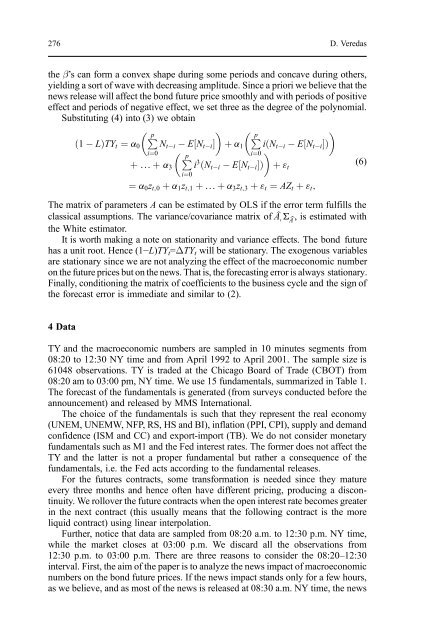recent developments in high frequency financial ... - Index of
recent developments in high frequency financial ... - Index of
recent developments in high frequency financial ... - Index of
Create successful ePaper yourself
Turn your PDF publications into a flip-book with our unique Google optimized e-Paper software.
276<br />
the β’s can form a convex shape dur<strong>in</strong>g some periods and concave dur<strong>in</strong>g others,<br />
yield<strong>in</strong>g a sort <strong>of</strong> wave with decreas<strong>in</strong>g amplitude. S<strong>in</strong>ce a priori we believe that the<br />
news release will affect the bond future price smoothly and with periods <strong>of</strong> positive<br />
effect and periods <strong>of</strong> negative effect, we set three as the degree <strong>of</strong> the polynomial.<br />
Substitut<strong>in</strong>g (4) <strong>in</strong>to (3) we obta<strong>in</strong><br />
ð1LÞTYt ¼ 0<br />
P p<br />
i¼0<br />
þ :::þ 3<br />
Nt i ENt ½ iŠ<br />
þ 1<br />
Pp iNt ð i ENt ½ iŠÞ<br />
P<br />
i¼0<br />
p<br />
i3ðNtiENt ½ iŠÞ<br />
þ "t<br />
i¼0<br />
¼ 0zt;0 þ 1zt;1 þ :::þ 3zt;3 þ "t ¼ AZt þ "t;<br />
The matrix <strong>of</strong> parameters A can be estimated by OLS if the error term fulfills the<br />
classical assumptions. The variance/covariance matrix <strong>of</strong> bA , is estimated with<br />
0 bA<br />
the White estimator.<br />
It is worth mak<strong>in</strong>g a note on stationarity and variance effects. The bond future<br />
has a unit root. Hence (1−L)TY t=ΔTYt will be stationary. The exogenous variables<br />
are stationary s<strong>in</strong>ce we are not analyz<strong>in</strong>g the effect <strong>of</strong> the macroeconomic number<br />
on the future prices but on the news. That is, the forecast<strong>in</strong>g error is always stationary.<br />
F<strong>in</strong>ally, condition<strong>in</strong>g the matrix <strong>of</strong> coefficients to the bus<strong>in</strong>ess cycle and the sign <strong>of</strong><br />
the forecast error is immediate and similar to (2).<br />
4 Data<br />
D. Veredas<br />
TY and the macroeconomic numbers are sampled <strong>in</strong> 10 m<strong>in</strong>utes segments from<br />
08:20 to 12:30 NY time and from April 1992 to April 2001. The sample size is<br />
61048 observations. TY is traded at the Chicago Board <strong>of</strong> Trade (CBOT) from<br />
08:20 am to 03:00 pm, NY time. We use 15 fundamentals, summarized <strong>in</strong> Table 1.<br />
The forecast <strong>of</strong> the fundamentals is generated (from surveys conducted before the<br />
announcement) and released by MMS International.<br />
The choice <strong>of</strong> the fundamentals is such that they represent the real economy<br />
(UNEM, UNEMW, NFP, RS, HS and BI), <strong>in</strong>flation (PPI, CPI), supply and demand<br />
confidence (ISM and CC) and export-import (TB). We do not consider monetary<br />
fundamentals such as M1 and the Fed <strong>in</strong>terest rates. The former does not affect the<br />
TY and the latter is not a proper fundamental but rather a consequence <strong>of</strong> the<br />
fundamentals, i.e. the Fed acts accord<strong>in</strong>g to the fundamental releases.<br />
For the futures contracts, some transformation is needed s<strong>in</strong>ce they mature<br />
every three months and hence <strong>of</strong>ten have different pric<strong>in</strong>g, produc<strong>in</strong>g a discont<strong>in</strong>uity.<br />
We rollover the future contracts when the open <strong>in</strong>terest rate becomes greater<br />
<strong>in</strong> the next contract (this usually means that the follow<strong>in</strong>g contract is the more<br />
liquid contract) us<strong>in</strong>g l<strong>in</strong>ear <strong>in</strong>terpolation.<br />
Further, notice that data are sampled from 08:20 a.m. to 12:30 p.m. NY time,<br />
while the market closes at 03:00 p.m. We discard all the observations from<br />
12:30 p.m. to 03:00 p.m. There are three reasons to consider the 08:20–12:30<br />
<strong>in</strong>terval. First, the aim <strong>of</strong> the paper is to analyze the news impact <strong>of</strong> macroeconomic<br />
numbers on the bond future prices. If the news impact stands only for a few hours,<br />
as we believe, and as most <strong>of</strong> the news is released at 08:30 a.m. NY time, the news<br />
(6)










